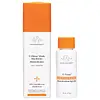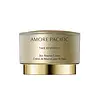What's inside
What's inside
 Key Ingredients
Key Ingredients

 Benefits
Benefits

 Concerns
Concerns

No concerns
 Ingredients Side-by-side
Ingredients Side-by-side

Water
Skin ConditioningDimethyl Isosorbide
SolventAscorbic Acid
AntioxidantLaureth-23
CleansingGlycerin
HumectantTocopherol
AntioxidantLactobacillus/Pumpkin Ferment Extract
Skin ConditioningSclerocarya Birrea Seed Oil
HumectantDipotassium Glycyrrhizate
HumectantGlycyrrhiza Glabra Root Extract
BleachingVitis Vinifera Juice Extract
AntioxidantFerulic Acid
AntimicrobialPhyllanthus Emblica Fruit Extract
HumectantCamellia Sinensis Leaf Extract
AntimicrobialLactobacillus/Punica Granatum Fruit Ferment Extract
Skin ConditioningPropanediol
SolventGluconolactone
Skin ConditioningSodium Hyaluronate Crosspolymer
HumectantSodium Hyaluronate
HumectantOryza Sativa Bran Extract
Skin ConditioningGlutamylamidoethyl Imidazole
Tetrahydrobisdemethoxydiferuloylmethane
AntioxidantTetrahydrodemethoxydiferuloylmethane
AntioxidantTetrahydrodiferuloylmethane
AntioxidantPentylene Glycol
Skin ConditioningCaprylhydroxamic Acid
Leuconostoc/Radish Root Ferment Filtrate
AntimicrobialSorbic Acid
PreservativePhenoxyethanol
PreservativeSodium Benzoate
MaskingCaprylyl Glycol
EmollientChondrus Crispus Extract
Skin ConditioningEthylhexylglycerin
Skin ConditioningWater, Dimethyl Isosorbide, Ascorbic Acid, Laureth-23, Glycerin, Tocopherol, Lactobacillus/Pumpkin Ferment Extract, Sclerocarya Birrea Seed Oil, Dipotassium Glycyrrhizate, Glycyrrhiza Glabra Root Extract, Vitis Vinifera Juice Extract, Ferulic Acid, Phyllanthus Emblica Fruit Extract, Camellia Sinensis Leaf Extract, Lactobacillus/Punica Granatum Fruit Ferment Extract, Propanediol, Gluconolactone, Sodium Hyaluronate Crosspolymer, Sodium Hyaluronate, Oryza Sativa Bran Extract, Glutamylamidoethyl Imidazole, Tetrahydrobisdemethoxydiferuloylmethane, Tetrahydrodemethoxydiferuloylmethane, Tetrahydrodiferuloylmethane, Pentylene Glycol, Caprylhydroxamic Acid, Leuconostoc/Radish Root Ferment Filtrate, Sorbic Acid, Phenoxyethanol, Sodium Benzoate, Caprylyl Glycol, Chondrus Crispus Extract, Ethylhexylglycerin
Camellia Sinensis Leaf Water
MaskingButylene Glycol
HumectantWater
Skin ConditioningGlycerin
HumectantHydrogenated Olive Oil Lauryl Esters
Emulsion StabilisingJojoba Esters
EmollientDimethicone
EmollientButyrospermum Parkii Butter
Skin ConditioningBetaine
HumectantDipropylene Glycol
HumectantHydrogenated Poly(C6-14 Olefin)
EmollientPentaerythrityl Tetraethylhexanoate
EmollientHelianthus Annuus Seed Oil
EmollientDiisostearyl Malate
EmollientHydrogenated Polyisobutene
EmollientCyclopentasiloxane
EmollientCetearyl Alcohol
EmollientPropanediol
SolventPEG-40 Stearate
EmulsifyingHydrogenated Lecithin
EmulsifyingPolysilicone-11
Polyglyceryl-10 Stearate
Skin ConditioningNiacinamide
Smoothing1,2-Hexanediol
Skin ConditioningGlyceryl Stearate
EmollientArachidyl Alcohol
EmollientBis-PEG-18 Methyl Ether Dimethyl Silane
EmollientParfum
MaskingBehenyl Alcohol
EmollientPEG-100 Stearate
Stearic Acid
CleansingSodium Polyacrylate
AbsorbentArachidyl Glucoside
EmulsifyingDipotassium Glycyrrhizate
HumectantCaffeine
Skin ConditioningGlyceryl Caprylate
EmollientAcrylates/C10-30 Alkyl Acrylate Crosspolymer
Emulsion StabilisingTromethamine
BufferingDipalmitoyl Hydroxyproline
Skin ConditioningHydrogenated Polydecene
EmollientPolyglyceryl-3 Methylglucose Distearate
EmulsifyingAdenosine
Skin ConditioningDisodium EDTA
Beta-Glucan
Skin ConditioningEthylhexylglycerin
Skin ConditioningPalmitic Acid
EmollientNatto Gum
Glycine Soja Seed Extract
Skin ConditioningCamellia Sinensis Leaf Extract
AntimicrobialPPG-5-Laureth-5
EmollientTheobroma Cacao Extract
Skin ConditioningDextrin
AbsorbentTocopherol
AntioxidantGlucose
HumectantPoloxamer 235
EmulsifyingEpigallocatechin Gallate
AntioxidantEthoxydiglycol
HumectantTocophersolan
AntioxidantPoloxamer 338
EmulsifyingPhenoxyethanol
PreservativePanax Ginseng Root Extract
EmollientBHT
AntioxidantMagnolia Obovata Bark Extract
Skin ConditioningCaprylyl Glycol
EmollientCamellia Sinensis Leaf Water, Butylene Glycol, Water, Glycerin, Hydrogenated Olive Oil Lauryl Esters, Jojoba Esters, Dimethicone, Butyrospermum Parkii Butter, Betaine, Dipropylene Glycol, Hydrogenated Poly(C6-14 Olefin), Pentaerythrityl Tetraethylhexanoate, Helianthus Annuus Seed Oil, Diisostearyl Malate, Hydrogenated Polyisobutene, Cyclopentasiloxane, Cetearyl Alcohol, Propanediol, PEG-40 Stearate, Hydrogenated Lecithin, Polysilicone-11, Polyglyceryl-10 Stearate, Niacinamide, 1,2-Hexanediol, Glyceryl Stearate, Arachidyl Alcohol, Bis-PEG-18 Methyl Ether Dimethyl Silane, Parfum, Behenyl Alcohol, PEG-100 Stearate, Stearic Acid, Sodium Polyacrylate, Arachidyl Glucoside, Dipotassium Glycyrrhizate, Caffeine, Glyceryl Caprylate, Acrylates/C10-30 Alkyl Acrylate Crosspolymer, Tromethamine, Dipalmitoyl Hydroxyproline, Hydrogenated Polydecene, Polyglyceryl-3 Methylglucose Distearate, Adenosine, Disodium EDTA, Beta-Glucan, Ethylhexylglycerin, Palmitic Acid, Natto Gum, Glycine Soja Seed Extract, Camellia Sinensis Leaf Extract, PPG-5-Laureth-5, Theobroma Cacao Extract, Dextrin, Tocopherol, Glucose, Poloxamer 235, Epigallocatechin Gallate, Ethoxydiglycol, Tocophersolan, Poloxamer 338, Phenoxyethanol, Panax Ginseng Root Extract, BHT, Magnolia Obovata Bark Extract, Caprylyl Glycol
 Reviews
Reviews

Alternatives
Ingredients Explained
These ingredients are found in both products.
Ingredients higher up in an ingredient list are typically present in a larger amount.
Camellia Sinensis Leaf Extract is derived from the leaves of the tea plant. Black tea, green tea, and oolong tea are all harvested from this plant.
This ingredient has many skin benefits:
This ingredient contains polyphenols, a strong antioxidant. Antioxidants help fight off molecules that damage skin cells.
On top of that, the antioxidants in green tea neutralize free-radicals from the sun. This gives the skin some extra UV protection, but should not replace sunscreen.
Many components of tea have anti-inflammatory properties.
Polyphenols and L-theanine help soothe the skin and reduce irritation. The caffeine in Camellia Sinensis Leaf Extract helps calm inflamed blood vessels.
Other compounds found in tea include: Vitamin Bs, linoleic acid, magnesium, calcium, iron, and zinc.
Research has shown both drinking Camellia Sinensis Leaf Tea and applying it to the skin can help boost skin elasticity and hydration. Studies also show using tea extract may reduce sebum, or oil, production.
Learn more about Camellia Sinensis Leaf ExtractCaprylyl Glycol is a humectant and emollient, meaning it attracts and preserves moisture.
It is a common ingredient in many products, especially those designed to hydrate skin. The primary benefits are retaining moisture, skin softening, and promoting a healthy skin barrier.
Though Caprylyl Glycol is an alcohol derived from fatty acids, it is not the kind that can dry out skin.
This ingredient is also used as a preservative to extend the life of products. It has slight antimicrobial properties.
Learn more about Caprylyl GlycolDipotassium Glycyrrhizate comes from licorice root.
Extracts of licorice have demonstrated to have antibacterial, anti‐inflammatory, antiviral, antioxidant properties.
One component, glabridin, has extra potent antioxidant and soothing properties. It has also been found to block pigmentation from UVB rays in guinea pigs.
Licorice Root also contains a flavonoid. Flavonoids are a natural substance from in plants. Flavonoids also have antioxidant properties.
Another component, glycyrrhizin, has been found to have anti-inflammatory and antimicrobial benefits. This may make licorice root extract effective at treating acne. However, more research is needed to support this.
Liquiritin is one of the flavone compounds found in licorice. It has been found to help lighten skin by preventing tyrosinase from reacting with tyrosine. When the two react, protein is converted to melanin. Melanin is the substance in your body that gives your features pigmentation.
Licorice root is native to Southern Europe and Asia. It has been used in traditional Chinese medicine to help with respiratory issues.
Learn more about Dipotassium GlycyrrhizateEthylhexylglycerin (we can't pronounce this either) is commonly used as a preservative and skin softener. It is derived from glyceryl.
You might see Ethylhexylglycerin often paired with other preservatives such as phenoxyethanol. Ethylhexylglycerin has been found to increase the effectiveness of these other preservatives.
Glycerin is already naturally found in your skin. It helps moisturize and protect your skin.
A study from 2016 found glycerin to be more effective as a humectant than AHAs and hyaluronic acid.
As a humectant, it helps the skin stay hydrated by pulling moisture to your skin. The low molecular weight of glycerin allows it to pull moisture into the deeper layers of your skin.
Hydrated skin improves your skin barrier; Your skin barrier helps protect against irritants and bacteria.
Glycerin has also been found to have antimicrobial and antiviral properties. Due to these properties, glycerin is often used in wound and burn treatments.
In cosmetics, glycerin is usually derived from plants such as soybean or palm. However, it can also be sourced from animals, such as tallow or animal fat.
This ingredient is organic, colorless, odorless, and non-toxic.
Glycerin is the name for this ingredient in American English. British English uses Glycerol/Glycerine.
Learn more about GlycerinPhenoxyethanol is a preservative that has germicide, antimicrobial, and aromatic properties. Studies show that phenoxyethanol can prevent microbial growth. By itself, it has a scent that is similar to that of a rose.
It's often used in formulations along with Caprylyl Glycol to preserve the shelf life of products.
Propanediol is an all-star ingredient. It softens, hydrates, and smooths the skin.
It’s often used to:
Propanediol is not likely to cause sensitivity and considered safe to use. It is derived from corn or petroleum with a clear color and no scent.
Learn more about PropanediolTocopherol (also known as Vitamin E) is a common antioxidant used to help protect the skin from free-radicals and strengthen the skin barrier. It's also fat soluble - this means our skin is great at absorbing it.
Vitamin E also helps keep your natural skin lipids healthy. Your lipid skin barrier naturally consists of lipids, ceramides, and fatty acids. Vitamin E offers extra protection for your skin’s lipid barrier, keeping your skin healthy and nourished.
Another benefit is a bit of UV protection. Vitamin E helps reduce the damage caused by UVB rays. (It should not replace your sunscreen). Combining it with Vitamin C can decrease sunburned cells and hyperpigmentation after UV exposure.
You might have noticed Vitamin E + C often paired together. This is because it is great at stabilizing Vitamin C. Using the two together helps increase the effectiveness of both ingredients.
There are often claims that Vitamin E can reduce/prevent scarring, but these claims haven't been confirmed by scientific research.
Learn more about TocopherolWater. It's the most common cosmetic ingredient of all. You'll usually see it at the top of ingredient lists, meaning that it makes up the largest part of the product.
So why is it so popular? Water most often acts as a solvent - this means that it helps dissolve other ingredients into the formulation.
You'll also recognize water as that liquid we all need to stay alive. If you see this, drink a glass of water. Stay hydrated!
Learn more about Water